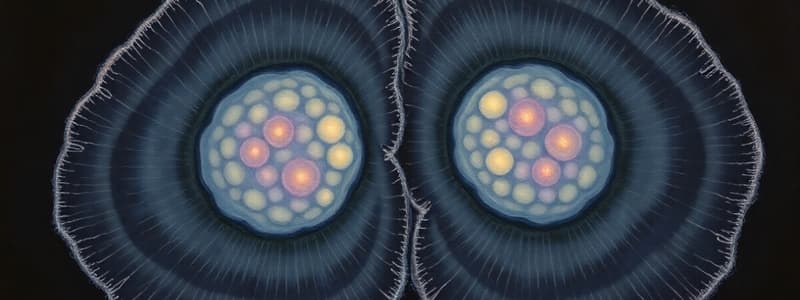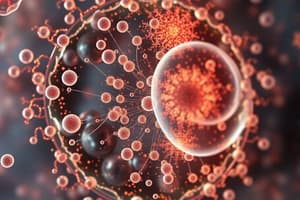Podcast
Questions and Answers
A cell is observed to have replicated its DNA and is performing its normal cellular functions. According to the stages of mitotic cell division, in which phase is this cell most likely to be?
A cell is observed to have replicated its DNA and is performing its normal cellular functions. According to the stages of mitotic cell division, in which phase is this cell most likely to be?
- Prophase
- Interphase (correct)
- Metaphase
- Telophase
During which phase of mitosis do sister chromatids separate and move towards opposite poles of the cell?
During which phase of mitosis do sister chromatids separate and move towards opposite poles of the cell?
- Metaphase
- Telophase
- Anaphase (correct)
- Prophase
If a researcher is observing a cell under a microscope and notices that the chromosomes are lined up at the center of the cell, which phase of mitosis is the cell in?
If a researcher is observing a cell under a microscope and notices that the chromosomes are lined up at the center of the cell, which phase of mitosis is the cell in?
- Anaphase
- Telophase
- Prophase
- Metaphase (correct)
The nuclear membrane reforms and chromosomes decondense into chromatin during which stage of mitosis, effectively marking the end of nuclear division?
The nuclear membrane reforms and chromosomes decondense into chromatin during which stage of mitosis, effectively marking the end of nuclear division?
Which cellular structures are directly responsible for the movement of chromosomes during mitosis?
Which cellular structures are directly responsible for the movement of chromosomes during mitosis?
Which of the following best describes the primary role of mitosis in multicellular organisms?
Which of the following best describes the primary role of mitosis in multicellular organisms?
If a eukaryotic organism is unable to perform mitosis, what would be the most likely consequence?
If a eukaryotic organism is unable to perform mitosis, what would be the most likely consequence?
A skin cell on your hand is damaged. Which process is directly responsible for replacing that cell with a new, identical skin cell?
A skin cell on your hand is damaged. Which process is directly responsible for replacing that cell with a new, identical skin cell?
How does mitosis contribute to the development of a zygote into a multicellular organism?
How does mitosis contribute to the development of a zygote into a multicellular organism?
Why is it important that DNA is copied during mitosis?
Why is it important that DNA is copied during mitosis?
Flashcards
Interphase
Interphase
The phase preceding mitosis where the cell replicates DNA and performs normal functions.
Prophase
Prophase
The first phase of mitosis where DNA coils into X-shaped chromosomes, and the nuclear membrane dissolves.
Metaphase
Metaphase
Chromosomes align in the middle of the cell, ready for separation.
Anaphase
Anaphase
Signup and view all the flashcards
Telophase
Telophase
Signup and view all the flashcards
Mitosis
Mitosis
Signup and view all the flashcards
Purpose of Mitosis
Purpose of Mitosis
Signup and view all the flashcards
Zygote
Zygote
Signup and view all the flashcards
Mitosis and Growth
Mitosis and Growth
Signup and view all the flashcards
Mitosis and Repair
Mitosis and Repair
Signup and view all the flashcards
Study Notes
- Eukaryotic organisms grow through mitosis, a process of cellular division.
- During mitosis, a cell splits to form two daughter cells.
- The cell's DNA is copied, ensuring each new cell has a complete set of genetic information.
- Mitosis is how most cells in the human body replicate, enabling growth and repair.
Purpose of Mitosis
- Mitosis facilitates growth from a single cell (zygote) into a multicellular organism.
- It allows for the continued creation of cells through the division of cells (1 becomes 2, becomes 4, becomes 8 and so on)
- Mitosis replaces damaged or old cells, because most cells have a smaller life span than the organism
- Without mitosis, wounds would not heal.
Mitosis Phases
- Mitosis includes four phases: prophase, metaphase, anaphase, and telophase, preceded by interphase.
- Organelles assist in cell division during these phases.
Interphase
- Interphase precedes mitosis and occupies most of the cell's life.
- DNA replication occurs in the nucleus during this phase.
Prophase
- DNA coils into distinct, x-shaped chromosomes visible under a microscope.
- Each chromosome comprises two sister chromatids connected at the centromere.
- The nuclear membrane dissolves.
- Centrioles position at polar ends and extend spindle fibers.
Metaphase
- Chromosomes align end to end along the middle of the cell.
- Spindle fibers from centrioles attach to the centromere of each chromosome.
Anaphase
- Chromosomes are halved as sister chromatids are pulled apart by spindle fibers.
- The cell stretches, and the center begins to pinch together.
Telophase
- The parent cell membrane continues to pinch until two separate daughter cells form.
- Spindle fibers disconnect and a new membrane forms around the chromatids, forming a a new nucleus in each cell.
- This separation and nucleus formation stage is also called cytokinesis.
Studying That Suits You
Use AI to generate personalized quizzes and flashcards to suit your learning preferences.




